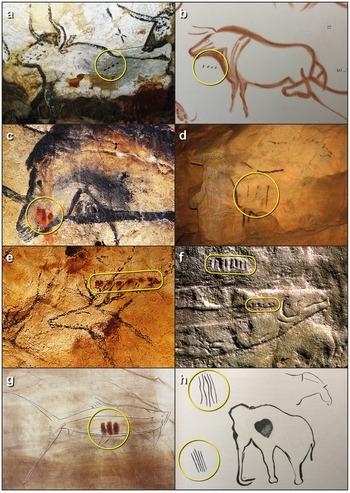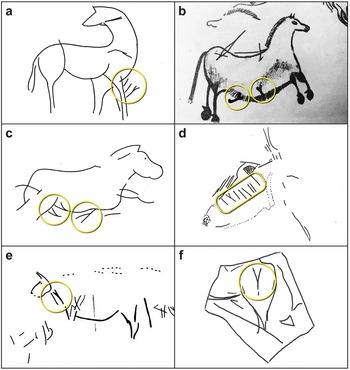Cambridge University Press
Source - https://www.cambridge.org/core/journals/cambridge-archaeological-journal/article/an-upper-palaeolithic-protowriting-system-and-phenological-calendar/6F2AD8A705888F2226FE857840B4FE19#article
Abstract
In at least 400 European caves such as Lascaux, Chauvet and Altamira, Upper Palaeolithic Homo sapiens groups drew, painted and engraved non-figurative signs from at least ~42,000 BP and figurative images (notably animals) from at least 37,000 BP. Since their discovery ~150 years ago, the purpose or meaning of European Upper Palaeolithic non-figurative signs has eluded researchers. Despite this, specialists assume that they were notational in some way. Using a database of images spanning the European Upper Palaeolithic, we suggest how three of the most frequently occurring signs—the line <|>, the dot <•>, and the <Y>—functioned as units of communication. We demonstrate that when found in close association with images of animals the line <|> and dot <•> constitute numbers denoting months, and form constituent parts of a local phenological/meteorological calendar beginning in spring and recording time from this point in lunar months. We also demonstrate that the <Y> sign, one of the most frequently occurring signs in Palaeolithic non-figurative art, has the meaning <To Give Birth>. The position of the <Y> within a sequence of marks denotes month of parturition, an ordinal representation of number in contrast to the cardinal representation used in tallies. Our data indicate that the purpose of this system of associating animals with calendar information was to record and convey seasonal behavioural information about specific prey taxa in the geographical regions of concern. We suggest a specific way in which the pairing of numbers with animal subjects constituted a complete unit of meaning—a notational system combined with its subject—that provides us with a specific insight into what one set of notational marks means. It gives us our first specific reading of European Upper Palaeolithic communication, the first known writing in the history of Homo sapiens.
 Figure 1 (opposite).Examples of animal depictions associated with sequences of dots/lines. (a) Aurochs: Lascaux, late period; (b) Aurochs: La Pasiega, late; (c) Horse: Chauvet, late (we differ in opinion with the Chauvet team, for whom it would be early); (d) Horse: Mayenne-Sciences, early; (e) Red Deer: Lascaux, late; (f) Salmon: Abri du Poisson, early; (g) Salmon (?): Pindal, late; (h) Mammoth: Pindal, early. (Sources: (a) https://commons.wikimedia.org/wiki/File:Lascaux_004.jpg (b) Breuil et al.1913, pl. XVIII; (c) free https://web.archive.org/web/20120222092520/http://www.istmira.com/foto-i-video-pervobytnoe-obschestvo/3924-iskusstvo-predystorii-pervobytnost-2.html (d) https://www.hominides.com/musees-et-sites/grotte-mayenne-sciences/ (e) Wellcome Collection. Attribution 4.0 International (CC BY 4.0); (f) © The Wendel Collection, Neanderthal Museum; (g) Berenguer 1994, 92, fig. 63; (h) H. Breuil, in del Rio et al.1911, 61, fig. 57.)
Figure 1 (opposite).Examples of animal depictions associated with sequences of dots/lines. (a) Aurochs: Lascaux, late period; (b) Aurochs: La Pasiega, late; (c) Horse: Chauvet, late (we differ in opinion with the Chauvet team, for whom it would be early); (d) Horse: Mayenne-Sciences, early; (e) Red Deer: Lascaux, late; (f) Salmon: Abri du Poisson, early; (g) Salmon (?): Pindal, late; (h) Mammoth: Pindal, early. (Sources: (a) https://commons.wikimedia.org/wiki/File:Lascaux_004.jpg (b) Breuil et al.1913, pl. XVIII; (c) free https://web.archive.org/web/20120222092520/http://www.istmira.com/foto-i-video-pervobytnoe-obschestvo/3924-iskusstvo-predystorii-pervobytnost-2.html (d) https://www.hominides.com/musees-et-sites/grotte-mayenne-sciences/ (e) Wellcome Collection. Attribution 4.0 International (CC BY 4.0); (f) © The Wendel Collection, Neanderthal Museum; (g) Berenguer 1994, 92, fig. 63; (h) H. Breuil, in del Rio et al.1911, 61, fig. 57.)
 Figure 2. Examples of the sign in sequences associated with animal depictions. (a) Horse: Pair-non-Pair, early, sign in position 3 in sequence of 3; (b) Horse: Lascaux, late, sign in position 1 of sequence of 1; (c) Horse: Sotarizza, late, sign in position 1 of sequence of 1; (d) Chamois: Labastide, late, sign in position 2 in sequence of 7; (e) Horse: Commarque, late, sign in position 2 in sequence of 2; (f) Horse (?): Parpalló, late, sign in position 1 of sequence of 1. (Sources: (a): B. Bacon; (b) Vialou 1979; (c) B. Bacon, after García Guinea 1975; (d) B. Bacon, after Omnès 1982; (e) Delluc & Delluc 1981, fig. 39; (f) B. Bacon, after Fortea Pérez 1978.)
Figure 2. Examples of the sign in sequences associated with animal depictions. (a) Horse: Pair-non-Pair, early, sign in position 3 in sequence of 3; (b) Horse: Lascaux, late, sign in position 1 of sequence of 1; (c) Horse: Sotarizza, late, sign in position 1 of sequence of 1; (d) Chamois: Labastide, late, sign in position 2 in sequence of 7; (e) Horse: Commarque, late, sign in position 2 in sequence of 2; (f) Horse (?): Parpalló, late, sign in position 1 of sequence of 1. (Sources: (a): B. Bacon; (b) Vialou 1979; (c) B. Bacon, after García Guinea 1975; (d) B. Bacon, after Omnès 1982; (e) Delluc & Delluc 1981, fig. 39; (f) B. Bacon, after Fortea Pérez 1978.)